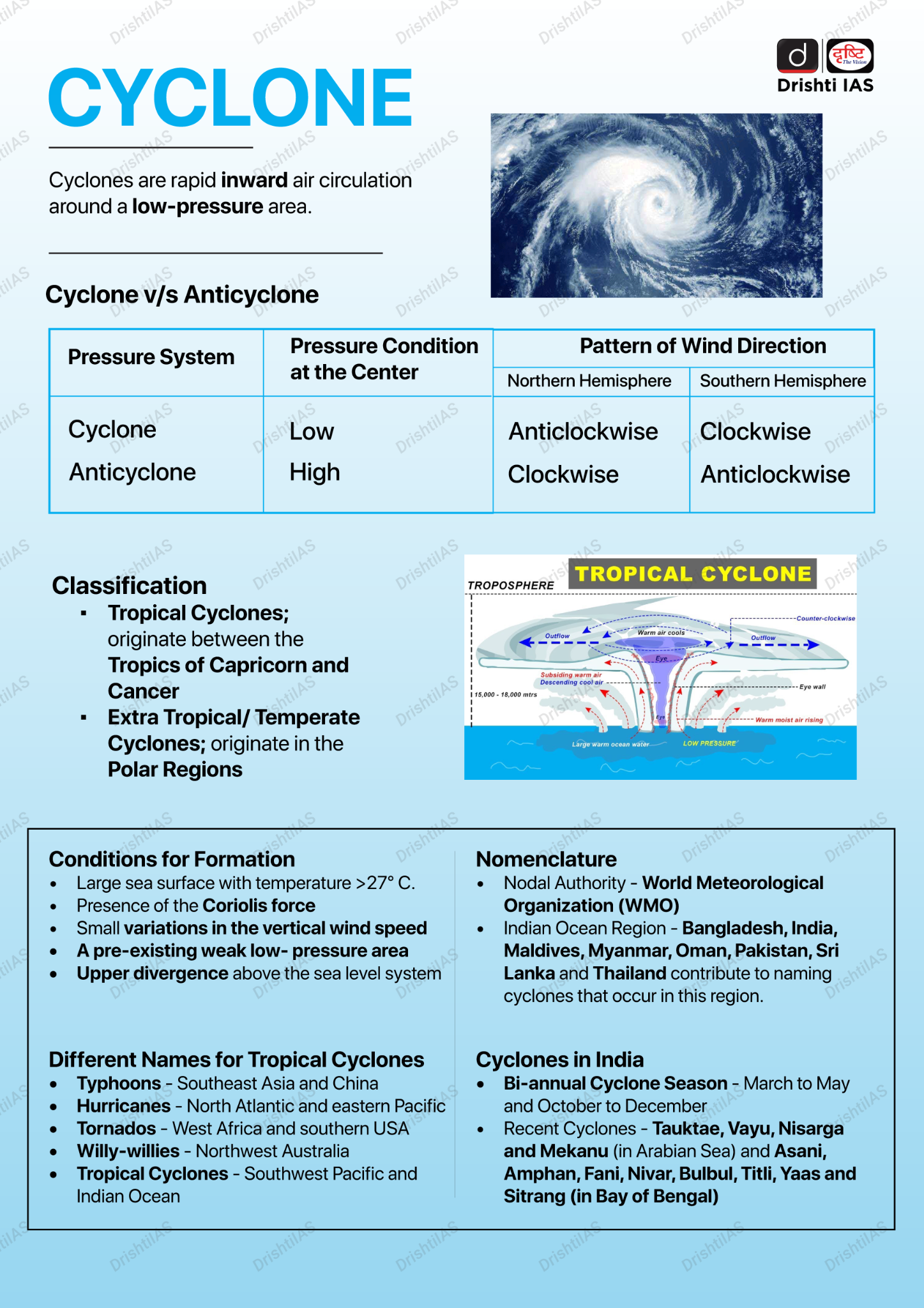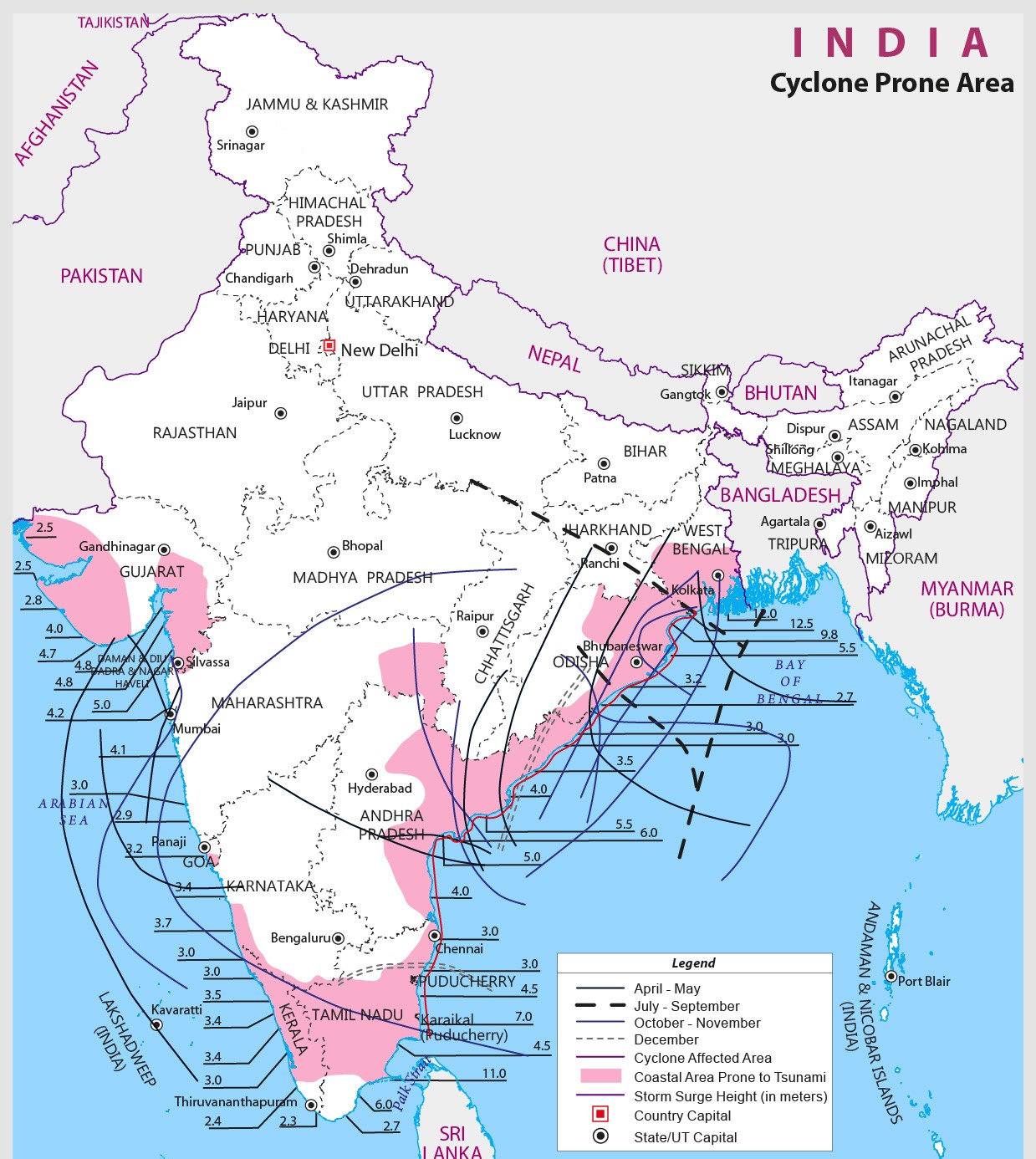Geography
Tropical Cyclones Need New Category
- 03 Apr 2024
- 6 min read
For Prelims: Tropical Cyclones Need New Category, Tropical Cyclones, Hurricanes, Saffir-Simpson (SS) Scale, Global Warming.
For Mains: Tropical Cyclones Need New Category, Important Geophysical phenomena such as earthquakes.
Why in News?
Recently, a study has been published in the journal Proceedings of National Academy of Sciences, where researchers have claimed that wind speed during a hurricane can cross 309 km/hour and therefore wind scale must add a Category 6.
What are the Key Highlights of the Study?
- Reconsideration of Saffir-Simpson (SS) Scale:
- There are concerns about the adequacy of the Saffir-Simpson (SS) Hurricane Wind Scale, which has been used for over 50 years to communicate hurricane risk based solely on wind speed.
- There are five categories on the SS hurricane wind scale — category 1 to category 5 — with category 5 wind speed exceeding 252 km/hour.
- The combined effects of wind, storm surge, and rainfall in a category 5 impact would completely raze any structure.
- There are five categories on the SS hurricane wind scale — category 1 to category 5 — with category 5 wind speed exceeding 252 km/hour.
- The open-ended Category 5 may no longer be sufficient to communicate the increasing risk of hurricane damage in a warming climate.

- There are concerns about the adequacy of the Saffir-Simpson (SS) Hurricane Wind Scale, which has been used for over 50 years to communicate hurricane risk based solely on wind speed.
- Introduction of Hypothetical Category 6:
- Due to Global Warming, there is now a need to define a category 6 cyclone.
- The warming can be observed not only at the sea surface, but also in the depths of the ocean, which increases the heat content of the ocean and thus favours the intensification of tropical cyclones.
- To address the limitations of the existing scale the introduction of a hypothetical Category 6 to the Saffir-Simpson Wind Scale is proposed with the wind speed above 309 km/hour.
- Due to Global Warming, there is now a need to define a category 6 cyclone.
- Impact of Global Warming on Hurricane Intensification:
- Increased greenhouse gas emissions have caused the Earth to warm by about 1.10 degrees Celsius since pre-industrial times and caused more intense tropical cyclones in the oceans.
- For every degree of warming, the strongest cyclones are getting 12% stronger, making them 40% more destructive.
- As the oceans warm, cyclones also strengthen faster and spend more lifetime over the oceans.
- In 2023, tropical cyclone Freddy spent 37 days over the oceans, making it the longest-lived cyclones ever recorded.
- Increased greenhouse gas emissions have caused the Earth to warm by about 1.10 degrees Celsius since pre-industrial times and caused more intense tropical cyclones in the oceans.
- Implications for Risk Messaging:
- The findings underscore the importance of revising risk messaging to better inform the public about the increased risk of major hurricanes due to global warming.
- SS Scale does not address issues related to inland flooding and storm surge, which are also critical components of hurricane risk.
- Therefore, changes in messaging beyond wind-based scales are necessary to adequately communicate the full spectrum of hurricane hazards.
Note:
- Once a tropical cyclone reaches maximum sustained winds of 119 km/hour or higher, it is then classified as a hurricane, typhoon, or tropical cyclone, depending upon where the storm originates in the world.
- In the North Atlantic, central North Pacific, and eastern North Pacific, the term hurricane is used.
- The Western Pacific basin is the most active region for tropical cyclones and accounts for about a third of the world’s tropical cyclones.
- The North Indian basin accounts for only about 4% of the global total, although it is one of the most vulnerable regions in the world to the effects of such cyclones.
What are Cyclones?
|
Drishti Mains Question: Q: Examine the limitations of the current Saffir-Simpson (SS) Scale and elucidate how the introduction of Category 6 can address these limitations. |
UPSC Civil Services Examination Previous Year Question (PYQ)
Prelims
Q. Consider the following statements: (2020)
- Jet streams occur in the Northern Hemisphere only.
- Only some cyclones develop an eye.
- The temperature inside the eye of a cyclone is nearly 10ºC lesser than that of the surroundings.
Which of the statements given above is/are correct?
(a) 1 only
(b) 2 and 3 only
(c) 2 only
(d) 1 and 3 only
Ans: (c)
Q. In the South Atlantic and South-Eastern Pacific regions in tropical latitudes, cyclone does not originate. What is the reason? (2015)
(a) Sea surface temperatures are low
(b) Inter-Tropical Convergence Zone seldom occurs
(c) Coriolis force is too weak
(d) Absence of land in those regions
Ans: (b)
Mains:
Q. Tropical cyclones are largely confined to the South China Sea, Bay of Bengal and Gulf of Mexico. Why? (2014)






